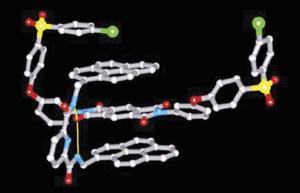Sequence-recognition in synthetic chemistry akin to biological systems
Many fundamental biological processes, including protein synthesis, involve recognising specific sequences of monomers in copolymers. However, synthetic chemistry has been slow to catch up with Nature’s ingenuity and sequence-recognition is rarely seen in synthetic systems.

Wanting to show that it wasn’t only biological systems that could process molecular-scale information Howard Colquhoun and his team used NMR spectroscopy to study the interactions between a tweezer-shaped organic molecule and a polyimide chain.
’We designed the tweezer so that it "reports" on the sequences it finds through its effects on the NMR spectrum of the polymer,’ explains Colquhoun. ’When the tweezer finds one, two or even three adjacent binding sites on the polymer chain, these are all reported in the form of separate NMR signals. The tweezer can thus read polymer sequences containing (so far) up to 27 aromatic rings.’
’The principles of sequence-recognition emerging from this work could have significant consequences for the development of information-processing systems working at the molecular level,’ speculates Colquhoun. And Tony Ryan, chairman of the Polymer Centre at the University of Sheffield, UK, agrees that the future of this work is promising: ’The availability of molecules that can be read points towards creating even more of the features of molecular biology using wholly synthetic molecules.’
’.this breakthrough by Colquhoun and co-workers is quite revolutionary,’ comments Ryan. ’The demonstration of supramolecular recognition of monomer sequence-information in linear copolymers is spectacular and opens up the field of molecular self-regulation and could even make repair possible.’
Caroline Evans
References
<man>b412801j</man>






No comments yet